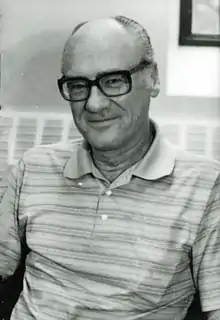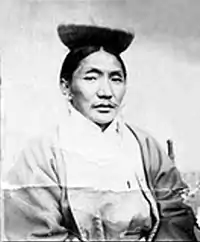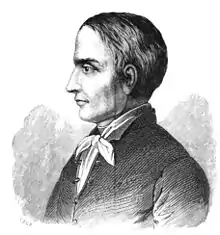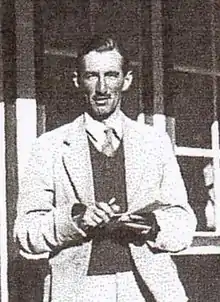Tibetology
Tibetology (Tibetan: བོད་རིག་པ།, Wylie: bod-rig-pa) refers to the study of things related to Tibet, including its history, religion, language, culture, politics and the collection of Tibetan articles of historical, cultural and religious significance. The last may mean a collection of Tibetan statues, shrines, Buddhist icons and holy scripts, Thangka embroideries, paintings and tapestries, jewellery, masks and other objects of fine Tibetan art and craftsmanship.
History

The Jesuit Antonio de Andrade (1580–1634) and a few others established a small mission and church in Tsaparang (1626), in the kingdom of Guge (Western Tibet) in the 17th century. When the kingdom was overrun by the king of Ladakh (1631), the mission was destroyed.
A century later another Jesuit, the Italian Ippolito Desideri (1684–1733) was sent to Tibet and received permission to stay in Lhasa where he spent 5 years (1716–1721) living in a Tibetan monastery, studying the language, the religion of the lamas and other Tibetan customs. He published a couple of books in Tibetan on Christian doctrine. Because of a conflict of jurisdiction (the mission was entrusted to the Capuchins, and not to the Jesuits) Desideri had to leave Tibet and returned to Italy, where he spent the rest of his life publishing his Historical notes on Tibet. They were collected, in 4 volumes, under the title of Opere Tibetane (Rome;1981–1989). Desideri may be considered as the first Tibetologist and he did much to make Tibet known in Europe.
Desideri was however a pioneer, and as such what he produced were rather 'observations' on Tibet, a work he did with objectivity and sympathy, but not always perfect accuracy. The inception of Tibetology as an authentic academic discipline is thus associated with the Hungarian Sándor Kőrösi Csoma (1784–1842) who is considered as its founder to present day, the other early Tibetologists of note being Philippe Édouard Foucaux who in 1842 occupied the first chair for Tibetan studies in Europe[lower-alpha 1] and Isaac Jacob Schmidt, who was primarily the pioneering mongolist residing in Saint Petersburg.
The publications of the British diplomat Charles Alfred Bell contributed towards the establishment of Tibetology as an academic discipline. As outstanding Tibetologists of the 20th century the British Frederick William Thomas, David Snellgrove, Michael Aris, and Richard Keith Sprigg, the Italians Giuseppe Tucci and Luciano Petech, the Frenchmen Jacques Bacot and Rolf Alfred Stein, finally the Germans Dieter Schuh and Klaus Sagaster, may be mentioned.
In recent decades, particularly in English-speaking countries, the study of Tibet and Tibetology has opened out towards other disciplines, prompting works with an interdisciplinary approach. This has become most obvious in the regular conferences of the IATS (International Association of Tibetan Studies), held at intervals of three years in different cities around the world. Examples of such broader-based research include the work of the American anthropologist Melvyn Goldstein, among others, who has produced publications on subjects such as lexical questions, Tibetan nomadism, and the modern history of Tibet. Other recent research includes the work of Robert Barnett, Matthew Kapstein, Elliot Sperling, Alex McKay, Geoffrey Samuel, Flavio Geisshuesler, among others.
Gallery
 Professor Turrell Wylie in 1979 at the University of Washington Department of Asian Languages and Literature
Professor Turrell Wylie in 1979 at the University of Washington Department of Asian Languages and Literature David Germano in 2013
David Germano in 2013 Giuseppe Tucci (1894-1984) Italian Tibetologist drinking butter tea in Tibet in the 1930s
Giuseppe Tucci (1894-1984) Italian Tibetologist drinking butter tea in Tibet in the 1930s.jpg.webp) Elliot Sperling 2014
Elliot Sperling 2014
 Sir Charles Alfred Bell, Author of the "Biography of the Dalai Lama" about the 13th Dalai Lama
Sir Charles Alfred Bell, Author of the "Biography of the Dalai Lama" about the 13th Dalai Lama Sándor Kőrösi Csoma authored the first Tibetan-English dictionary
Sándor Kőrösi Csoma authored the first Tibetan-English dictionary Hugh Richardson in Tibet about 1940
Hugh Richardson in Tibet about 1940 The Jesuit priest, Antonio de Andrade, born 1580, died 1634 was the first known European to have visited Tibet
The Jesuit priest, Antonio de Andrade, born 1580, died 1634 was the first known European to have visited Tibet
See also
References
Notes
- At the school of Oriental Studies in Paris. See:Le Calloc'h, Bernard. "Philippe-Edouard Foucaux: First Tibetan teacher in Europe." Tibet Journal 12.1 (1987): 39-49.
Citations
- Richardson, Hugh. "INTRODUCTION to The Tibet Journal, Vol. 15, No. 4, Shakabpa Memorial Issue: Part I (Winter 1990)". Library of Tibetan Works and Archives: 3–4. JSTOR 43300372.
{{cite journal}}: Cite journal requires|journal=(help) - "One Hundred Thousand Moons: An Advanced Political History of Tibet". Brill.com. Brill. Archived from the original on 16 March 2016. Retrieved 13 February 2018.
- Pommaret, Françoise. "Reviewed Work(s): One Hundred Thousand Moons: An Advanced Political History of Tibet. Vol. 1; Vol.2 by Tsepon Wangchuk Deden Shakabpa and Derek F. Maher Review by: Françoise Pommaret". The Journal of Asian Studies, Vol. 70, No. 1 (FEBRUARY 2011): Association for Asian Studies: 230–233. JSTOR 41302243.
{{cite journal}}: Cite journal requires|journal=(help)CS1 maint: location (link)
Other sources
- Tsering Shakya: The Development of Modern Tibetan Studies. In: Robert Barnett (Hg.): Resistance and Reform in Tibet (Bloomington/Indianapolis, Indiana University Press 1994), ISBN 0-253-31131-4, S. 1–14.
- SHAKABPA, W. D. 1967. Tibet: A Political History [With plates and maps.]. Yale University Press: New Haven & London.